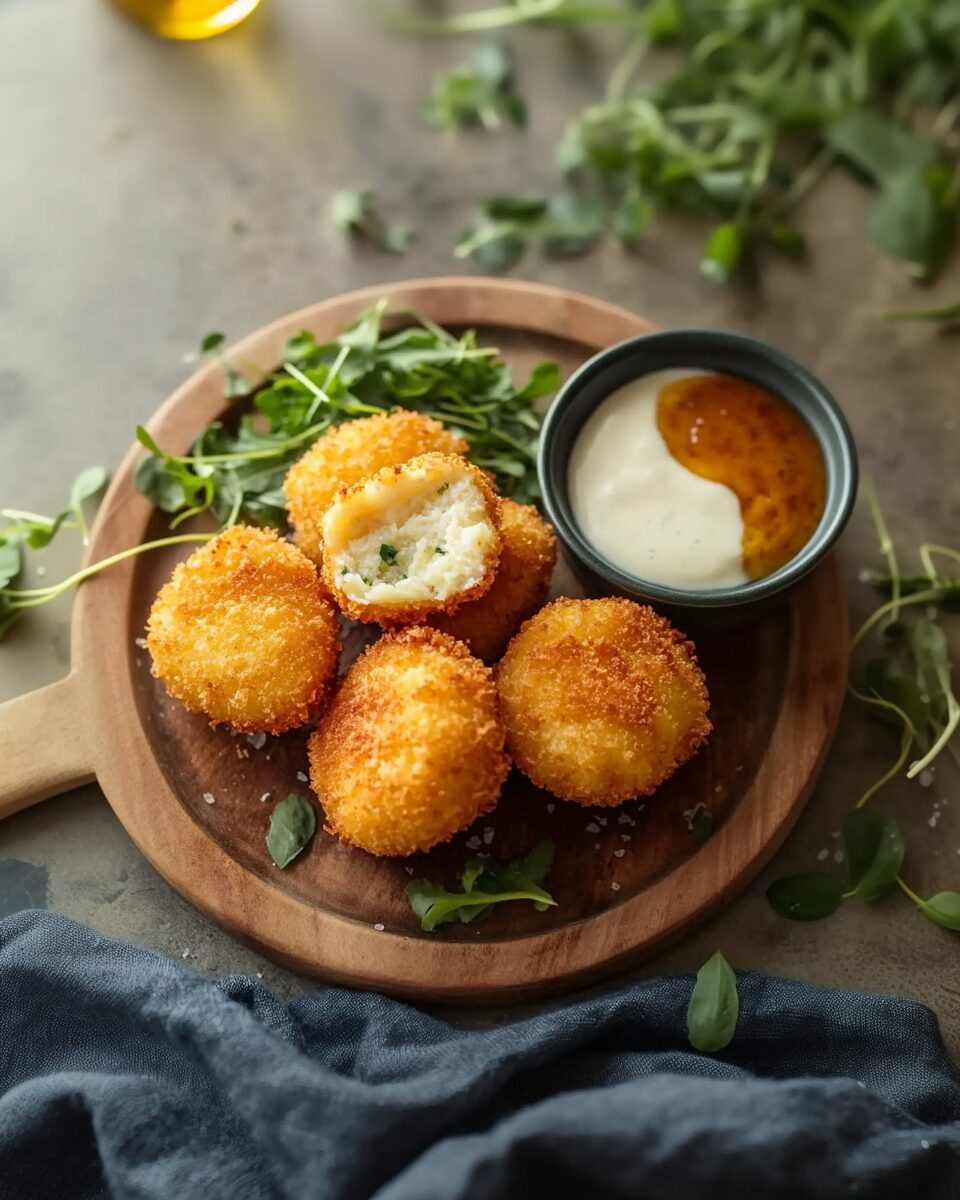Korokke, the Japanese twist on the classic French croquette, is a crispy, savory dish that’s beloved across Japan. It features mashed potatoes mixed with ground meat (often beef or pork), shaped into patties, coated in flour, egg, and panko breadcrumbs, then deep-fried until golden brown. Korokke are versatile—they can be served as a snack, side dish, or main meal, making them a staple in both home kitchens and bento boxes.
Full Recipe:
Ingredients
- 4 medium potatoes, peeled and chopped
- 200g ground beef or pork
- 1 small onion, finely diced
- 2 tablespoons soy sauce
- 1 tablespoon sugar
- 1/2 teaspoon salt
- 1/4 teaspoon black pepper
- 2 tablespoons butter
- Vegetable oil for frying
For Breading:
- 1/2 cup all-purpose flour
- 2 eggs, beaten
- 1 cup panko breadcrumbs
Directions
-
Boil the Potatoes: Place chopped potatoes in a pot of salted water. Bring to a boil and cook until soft. Drain and mash with butter, salt, and pepper.
-
Cook the Filling: In a pan, sauté the diced onion until translucent. Add ground meat, cook until browned. Stir in soy sauce and sugar. Cook until liquid is mostly evaporated.
-
Combine: Add the meat mixture to the mashed potatoes. Mix well and allow to cool slightly.
-
Shape the Patties: Divide the mixture into equal portions and form into oval or round patties.
-
Bread the Korokke: Dredge each patty in flour, dip into beaten egg, and coat with panko breadcrumbs.
-
Fry: Heat oil in a deep pan to 175°C (350°F). Fry patties in batches until golden brown and crispy, about 3-4 minutes per side. Drain on paper towels.
-
Serve: Best enjoyed hot, optionally with shredded cabbage or tonkatsu sauce on the side.
Nutritional Facts
Per Korokke (approximate):
- Calories: 200
- Protein: 8g
- Carbohydrates: 25g
- Dietary Fiber: 2g
- Sugars: 2g
- Fat: 8g
- Saturated Fat: 2g
- Cholesterol: 40mg
- Sodium: 300mg
- Potassium: 450mg
Historical Background
The origins of korokke trace back to the late 19th century during the Meiji era, a period marked by Japan’s rapid modernization and openness to Western influences. Introduced in 1887, the French croquette was adapted to suit Japanese tastes and ingredient availability. Due to limited dairy processing technology at the time, mashed potatoes replaced the traditional béchamel sauce found in French croquettes, leading to the creation of the potato-based korokke. The first mention of “kuroketto” appears in cookery books from the Meiji era, indicating the dish’s integration into Japanese cuisine.
Cultural Significance
Korokke holds a special place in Japanese food culture, serving as both a popular street food and a homemade comfort dish. Its affordability and satisfying taste have made it a staple in Japanese households. The dish’s versatility allows it to be enjoyed as a snack, side dish, or main course, often accompanied by shredded cabbage and a drizzle of tonkatsu sauce. The widespread availability of korokke in supermarkets and convenience stores attests to its enduring popularity.
Variations of Korokke
Over time, numerous variations of korokke have emerged, each offering a unique flavor profile:
-
Potato Korokke: The classic version made with mashed potatoes, sometimes flavored with ground meat or onions.
-
Meat Korokke: Incorporates ground meat, such as beef or pork, mixed with mashed potatoes for a heartier filling.
-
Kabocha Korokke: Utilizes kabocha squash, a Japanese winter squash similar to pumpkin, offering a naturally sweet flavor.
-
Curry Korokke: Infused with Japanese curry powder, providing a spicy and aromatic twist.
-
Cream Korokke: Features a creamy white sauce base, often combined with seafood like crab or shrimp, resulting in a rich and indulgent filling.
Preparation Techniques
While korokke is easy enough for home cooks, the dish still requires a few key steps for the best texture and flavor. The mashed potato or cream filling must be well seasoned and cooled before forming into patties. Proper breading with flour, egg, and panko ensures a crispy exterior, and deep-frying at the right temperature (about 175°C or 350°F) is essential for even browning. The use of Japanese panko breadcrumbs is what sets korokke apart, giving it that signature crunch without excessive heaviness.
The process of making korokke involves several key steps:
-
Filling Preparation: Ingredients such as mashed potatoes, ground meat, or vegetables are seasoned and combined to create the filling.
-
Shaping: The filling is molded into desired shapes, commonly flat ovals or cylindrical patties.
-
Breading: Each patty is coated in flour, dipped in beaten eggs, and then covered with panko breadcrumbs, which provide a light and crispy texture upon frying.
-
Frying: The breaded patties are deep-fried until they achieve a golden-brown exterior, resulting in a crunchy outside and a soft, flavorful inside.
Serving Suggestions
Korokke is versatile in its serving options:
-
As a Snack: Enjoyed on its own, often wrapped in paper for convenience.
-
In a Meal: Served alongside rice, miso soup, and salad as part of a traditional Japanese meal.
-
Korokke Pan: Sandwiched between slices of bread, known as korokke pan, making for a hearty and portable meal.
-
Toppings: Commonly topped with tonkatsu sauce or a similar condiment to enhance flavor.
Global Influence and Adaptations
Though rooted in Japan, the idea of croquette-like foods spans the globe. Spanish croquetas, Dutch kroketten, Indian aloo tikki, and Indonesian kroket all bear similarities to korokke. What makes Japan’s version unique is the consistent use of panko breadcrumbs and its combination of both European and Japanese seasonings. As Japanese food grows in global popularity, korokke has made its way onto international menus in sushi bars, izakayas, and even Western-style bistros. The concept of the croquette has been embraced and adapted worldwide, leading to various regional interpretations:
Spain: Known as croquetas, these are typically filled with béchamel sauce mixed with ingredients like ham, chicken, or cod.
-
Netherlands: Referred to as kroket, Dutch croquettes are often filled with a ragout of meat or shrimp and are a popular snack.
-
Indonesia: Introduced during Dutch colonial rule, kroket is made with mashed potatoes filled with minced chicken or ragout, showcasing a blend of Dutch and Indonesian flavors.
-
India: Aloo tikki, a potato-filled croquette, is a popular snack in Northern India, often served with chutney or as part of a chaat.
Conclusion
Korokke exemplifies Japan’s ability to adapt and reinvent foreign culinary concepts, transforming the French croquette into a distinctly Japanese comfort food. Korokke, the Japanese twist on the classic French croquette, is a crispy, savory dish that’s beloved across Japan. It features mashed potatoes mixed with ground meat or vegetables, shaped into patties, coated in panko breadcrumbs, then deep-fried until golden brown. Korokke are versatile—they can be served as a snack, side dish, or main meal, making them a staple in both home kitchens and bento boxes. Despite its Western roots, korokke has become a deeply familiar and nostalgic dish in Japanese culture. Its enduring popularity is a testament to its delicious taste, versatility, and the cultural significance it holds within Japanese society.






